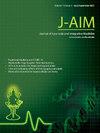Prakriti阐明了冠状动脉疾病风险预测生物标志物的个体间变异性:一项基于三级保健医院的病例对照研究
IF 1.9
Q3 INTEGRATIVE & COMPLEMENTARY MEDICINE
引用次数: 0
摘要
背景:几种生物化学测试和生物标志物在评估冠状动脉疾病(CAD)风险方面是众所周知的。然而,可能由于表型异质性,相互矛盾的结果提出了重大挑战。在阿育吠陀,个体被划分为表型——Prakriti,这有助于预测个体对疾病的易感性、预后和治疗选择。在目前的研究中,我们试图克服这一挑战,目的是确定阿育吠陀中提到的不同体质类型与精确预测CAD风险的生化标志物之间的联系。方法从印度新德里AIIMS心内科OPD招募临床稳定的冠心病患者200例和健康对照100例。进行了一套综合CAD病理生理学各个方面的测试。临床评估Prakriti,并采用基于AI/ML算法的有效问卷。结果冠心病患者的单核细胞淋巴细胞比(MLR)、空腹血糖、尿素、肌酐、尿酸、NT-pro BNP均显著高于健康对照组。Prakriti分层显示Kapha Prakriti患者最多。Vata患者的MLR和IL-6(与炎症和外周内皮功能障碍相关)较高;Kapha患者的糖尿病控制(与斑块不稳定和功能失调的RAAS相关)较差,而Pitta患者的NT-pro BNP(与心肌缺氧相关)较高。结论:虽然一些生化参数与冠心病的风险相关,但Prakriti分类提供了更准确的风险。这种双重方法可能有助于指导CAD管理中的个性化治疗选择。本文章由计算机程序翻译,如有差异,请以英文原文为准。
Prakriti elucidates the inter-individual variability in coronary artery disease risk-predicting biomarkers: A tertiary care hospital-based case control study
Background
Several biochemical tests and biomarkers are well-known for the assessment of risk towards coronary artery disease (CAD). However, conflicting results pose a significant challenge probably due to phenotypic heterogeneity. In Ayurveda, individuals are classified into phenotypes- Prakriti, which helps in predicting an individual's susceptibility to disease, its prognosis and selection of therapy. In the present study, an attempt was made to overcome this challenge with an aim to identify the association between different constitution types as mentioned in Ayurveda with biochemical markers for precisely predicting the risks for CAD.
Methods
200 clinically stable CAD patients and 100 healthy controls were recruited from the Cardiology OPD, AIIMS, New Delhi, India. A comprehensive set of tests to incorporate various aspects of CAD pathophysiology was performed. Assessment of Prakriti was done clinically and with AI/ML algorithm based validated questionnaire.
Results
The monocyte-lymphocyte ratio (MLR), fasting blood sugar, urea, creatinine, uric acid, and NT-pro BNP were significantly higher in CAD patients as compared to healthy controls. Prakriti stratification revealed maximum number of patients with Kapha Prakriti. MLR and IL-6 (associated with inflammatory and peripheral endothelial dysfunction) were high in Vata patients; diabetic control (associated with plaque instability and malfunctioned RAAS) was poor in Kapha patients and NT-pro BNP (associated with myocardial hypoxia) was higher in Pitta patients.
Conclusion
Though, several biochemical parameters were associated with risks for CAD, Prakriti classification provided more insights into the precise risks. This dual approach may help in guiding personalized treatment options in CAD management.
求助全文
通过发布文献求助,成功后即可免费获取论文全文。
去求助
来源期刊

Journal of Ayurveda and Integrative Medicine
INTEGRATIVE & COMPLEMENTARY MEDICINE-
CiteScore
4.70
自引率
12.50%
发文量
136
审稿时长
30 weeks
 求助内容:
求助内容: 应助结果提醒方式:
应助结果提醒方式:


